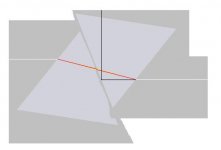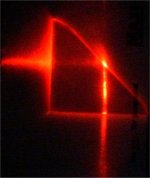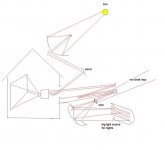Mathias, what about the blue spectrum? there is red green and blue to make up white light, the rainbow effects wont accur on a lcd, ive never seen this and about all u would see on a miss- matched light system is a blur, the rainbow effect could possibly be seen if the operating frequencty of the light is lower then the lcd's but even then with light combined already coming from each source combined into 1 u wont see this effect, the lcd filters this light with its own static colour filter. Dlp has this issue because the light beam is filterd into colour and operates at strict timming with a colour wheel, maybe u need to elaberate with this rainbow efect on a lcd because ive never seen it in my life.
Trev
Trev
I´m sending in white light into the prism from the lamps, if that is what you mean. If the rainbow effect is not a problem than this thing will be even simpler, angle the second lamp so the rays comes out in the same direction as the first.what about the blue spectrum
angle the second lamp so the rays comes out in the same direction as the first.
Thats all u need to do with using the 1 prisim
what do you think about this?
the first prism has a rainbow effect on the white light, the second reveals this effect, so one white light ray comes out. the black second light hits the second prism at a negative angle so this should be reflected and goes into the first light ray...
so i have one out of two beams...
based on this site and paint shop
http://www.uni-leipzig.de/~stann/java/prisma.html
the first prism has a rainbow effect on the white light, the second reveals this effect, so one white light ray comes out. the black second light hits the second prism at a negative angle so this should be reflected and goes into the first light ray...
so i have one out of two beams...
based on this site and paint shop
http://www.uni-leipzig.de/~stann/java/prisma.html
Attachments
it's a normal prism, fully made out of glass...
but anyways, as i looked on my budget i decided to give the single 150W bulbed version a try, as i saw good results in the german diy forum where this guy claims to have a 70W MH bulb and got a picture bright enough on an acceptable size.
May be the 150W will be enough to lighten a 15" tft; i'll give it try...
P.S.: Did you receive my adress?
but anyways, as i looked on my budget i decided to give the single 150W bulbed version a try, as i saw good results in the german diy forum where this guy claims to have a 70W MH bulb and got a picture bright enough on an acceptable size.
May be the 150W will be enough to lighten a 15" tft; i'll give it try...
P.S.: Did you receive my adress?
What I can see the mirrorprism will not work as a light mixer, even with lenses, the result out of that is a beam that is double as wide as high. And that is logical, to mix two beam you have to place them over each other and that is only possible with semipermeable material.Guys, im talking about using simple mirrored prisims here, its all u need, what prisims are u talking about? because u wont get a rainbow effect on a normal mirrored prisim.
Glassprism will not lose more light than a condensorlens, because a condensorlens is many small prisms.
the result out of that is a beam that is double as wide as high.
Hows this so? u could make this double wide depending of the angle of your choice, but not double high, its the same as having 2 mirrors but because with a mirror the peak cant be together Beacuse of the thickness of the mirror) you use a mirrored prisim, you have the sharp peak at the front so there isnt a gap in the lights center, noticable by the human eye anyway. You will find mathias no projector will use your idea, its impractical and runs costs very high.
Trev
Glassprism will not lose more light than a condensorlens, because a condensorlens is many small prisms.
A condenser lens is a lens, nothing to do with a prisim, prisims arent magnified unless your wer to order one that was. They are totally different.
Trev
Trev I don´t think you have tried your idea, you don´t need the mirror at all actully you can change the beam angle on the lamp instead but the problem is when you mix them together with the lenses. you can not change the angle because then you got a hole in the middle with no light.could make this double wide depending of the angle of your choice, but not double high
Even if my glassprism idea is not the best, it is in the right derection.
A condenser lens is a lens, nothing to do with a prisim
Wrong! Have you been on a physics lesson ?
Wrong! Have you been on a physics lesson ?
Teach me otherwise. The things u are talking about mathias are on a different level, this is about afordable and efiecient projection, we could go on and on all day about this, but at the end of the day it will cost so much not only in time, but also money making it not worth it.
Mathias, a lens is a lens, a prisim is a prisim, if they wer the same they would not be named a different name, a condenser lens is not a series of small prisims, if has SOME certain properties of a prisim but by all means it has nothing to do with a prisim, AND WILL NOT BE THE SAME. This is being told to me from my gf who has a master in quantum machanics, if you want to argue further about it, then i sujest argue with a proffesor in this feild, im not qualified nor yourself to be arguing in such issues without the relivant experience.
As for testing my theories out, i have actually, i tried it last year in june with 2 mirrors and 2 light sources with relevant reflectors. Ive told my findings, ive given my advice on how to get it to work and thats just it, unless your going to use a rear frensel u dont need a point source light, ive given you my findings, my advice, what you need and now the rest is upto you.
Trev
Yes thats right, why I bring this up was because you said a prism is loosing much light what I mean is that a condensor lens loose the same light.a lens is a lens, a prisim is a prisim
The only diffrens between prism and lenses are that lenses has a curved surface but they bend the light in the same way as a prism so there is nothing to say about that.
Anyway I have a simple solution to your mirror-lens design. It important to think in two demension X-Y, your design work if we use 4 lamps, to get it to work with 2 lamps we need two special lenses curved only on X-side and staight on the Y-side. X=--- Y=|||
Laser a good help
Here is a little tip to all diy:ers, a laser is a good instrument to measure lenses and control your setup with. It´s really intresting to see what happen when it goes through a fresnellens.....more than you think.
It´s friday night, so I show a cosy picture of a laserbeam through a prism.
Here is a little tip to all diy:ers, a laser is a good instrument to measure lenses and control your setup with. It´s really intresting to see what happen when it goes through a fresnellens.....more than you think.
It´s friday night, so I show a cosy picture of a laserbeam through a prism.
Attachments
Mathias, our problem in here on this matter is comunication lol, your talking about 1 thing while im talking about another, none of us is wrong, we are just talking with different parts on our mind that the other dont know but asumes its the part they are talking about lol, ill get into this abit latter on with you, but right now i got to finnish my project, by all means keep the tech rolling.
Trev
Trev
Solar projector
Hi people!
I am thinking about building a solar LCD projector i.e. I want
to build a sun tracking parabolic mirror that will collect the sun
rays, and from there I will make it become a small strait beem that
I will insert into the house and the projector through a window.
What do you think?
I am also thinking about what to do in the night. If I would put the
light engine outside and pass it also through the window i.e. it can
be very big, could I use cheeper/bigger light source(s) ?
Hi people!
I am thinking about building a solar LCD projector i.e. I want
to build a sun tracking parabolic mirror that will collect the sun
rays, and from there I will make it become a small strait beem that
I will insert into the house and the projector through a window.
What do you think?
I am also thinking about what to do in the night. If I would put the
light engine outside and pass it also through the window i.e. it can
be very big, could I use cheeper/bigger light source(s) ?
Attachments
The fresnel lenses that we use for DIY projectors are actually made up of two fresnel lenses that have been glued together. A split lens is one of the original lenses that has been un-glued. The reason this may be beneficial is that you can then place the LCD between the two lens halves, taking advantage of more ideal angle of incoming light rays.
You can cut down the fresnel to fit your LCD, but doing so does reduce the amount of light that you can collect. If you are using a 7" LCD for example, then I would recommend putting the LCD about 4" away from your fresnel lens (non-split) to get more of the light that comes out of your system. This will result in a much brighter image than if you were to cut the fresnel down to be the same size as your LCD.
Note: cutting and/or spliting a fresnel can sometime crack your fresnel lens. If you don't already have a fresnel lens and would like one that has been split, then you should purchase one that has been split for you. diylabs.org offers such lenses.
If you split your lens or buy one pre-split, and then you decide that you would like a single (normal) lens, then you can simply put the two lenses back together - they will function just as if they had never been split.
You can cut down the fresnel to fit your LCD, but doing so does reduce the amount of light that you can collect. If you are using a 7" LCD for example, then I would recommend putting the LCD about 4" away from your fresnel lens (non-split) to get more of the light that comes out of your system. This will result in a much brighter image than if you were to cut the fresnel down to be the same size as your LCD.
Note: cutting and/or spliting a fresnel can sometime crack your fresnel lens. If you don't already have a fresnel lens and would like one that has been split, then you should purchase one that has been split for you. diylabs.org offers such lenses.
If you split your lens or buy one pre-split, and then you decide that you would like a single (normal) lens, then you can simply put the two lenses back together - they will function just as if they had never been split.
If you don't already have a fresnel lens and would like one that has been split, then you should purchase one that has been split for you. diylabs.org offers such lenses.
These can be cut with a router that wont crack or damage the lens, also will not scratch the lens if setup in the right way.
If you are using a 7" LCD for example, then I would recommend putting the LCD about 4" away from your fresnel lens (non-split) to get more of the light that comes out of your system. This will result in a much brighter image than if you were to cut the fresnel down to be the same size as your LCD.
Yep that would work but it would be the same as having a huge ohp with a tinny lcd, would look prety darn silly imo, also there would be a heap of wasted light and light leaks. The better way is to get short focal frensels with the apropiate condenser so the light can be placed closer to the lcd and the light guided just to this size, it will far out perform then the above mentioned idea.
Trev
- Status
- This old topic is closed. If you want to reopen this topic, contact a moderator using the "Report Post" button.
- Home
- General Interest
- Everything Else
- The Moving Image
- DIY Projectors
- DIY Video Projector Part II


